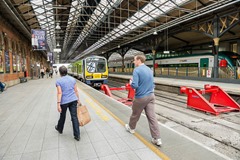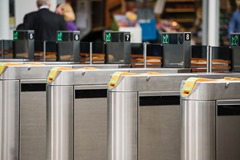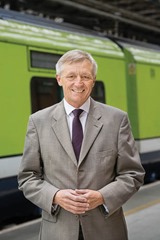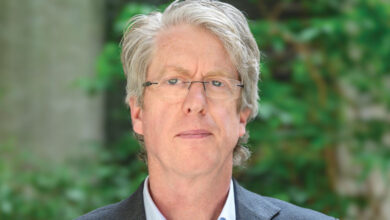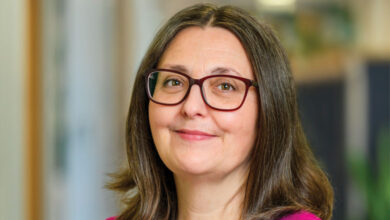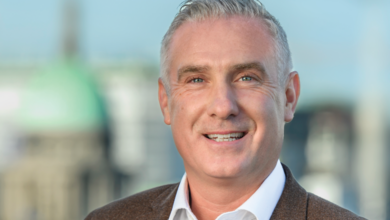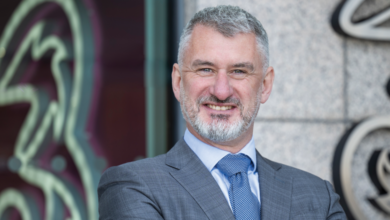Rail: growing into the future
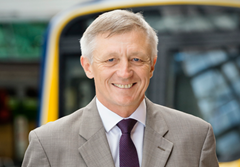 David Franks, Chief Executive of Iarnród Éireann, talks to Owen McQuade about the financial challenges facing the rail company and its plans for the future.
David Franks, Chief Executive of Iarnród Éireann, talks to Owen McQuade about the financial challenges facing the rail company and its plans for the future.
David Franks, Chief Executive of Iarnród Éireann and life-long railway man, starts by stating that all passenger operations are performing well. “We have a few little areas where occasionally we do not meet our own exacting standards,” he says. The company has delivered the contractual levels of performance “but we always strive to do better than that.” The routes that have caused some difficulty include the Dublin to Belfast route which operates over two jurisdictions, adding a degree of complexity. There have also been some problems on the Tralee route because of the number of level crossings but that has now been fixed and it is performing well. There have been some difficulties with some of the services down to Rosslare which get caught up in the DART network. “One of the reasons the Rosslare route sometimes does not perform well is that there are very few trains. If you have a train caught up in something it can make a big impact on the performance statistics. But overall our levels of performance are very good at the moment,” observes Franks.
This year passenger numbers grew overall in excess of 2 per cent, in the context of passenger numbers declining for five of the last six years. The last quarter of 2013 was the turning point. However, the growth has not been seen across the whole network. The commuter and DART business is doing much better but the intercity routes are growing at a slower rate and the main reason is that we are now seeing the full impact of the much improved motorway network, which was not evident through the economic crisis.
EU deregulation
When Franks arrived in January 2013 one of his first tasks was to split the company into two entities to meet the European Directive on rail deregulation. The company is now split into an infrastructure manager and a train operator, which in railway terms is called a railway undertaking. The infrastructure manager and director of train operations report to Franks – “it is not like in the UK where they are separate companies” – which reflects the small market size in Ireland.
As regards deregulation, there are still a couple of things the Government has to do. For example, to set up an essential functions body to allow another train operator to be set up and to ensure that the rights granted to them are on a fair and equal basis. There is a plan to do this but it is not yet in place. There has just been the appointment of a railway safety commissioner – “the rail regulator to ensure we deliver against our obligations.”
“Although we have no major operators entering the Irish rail market, there are some smaller players,” Franks remarks.
“This includes the Railway Preservation Society of Ireland (RPSI) and a joint service between Belfast and Dublin. To say that there is just one operator is not the case, when in fact you also include Balfour Beatty who operate some engineering trains.”
The intercity business is doing well from an operating performance perspective but its financial performance is more challenging. “When times were good financially, we spent money on fixing a lot of what was broken but the intercity routes did not get a lot of upgrading investment, certainly not enough investment to keep up with the motorway network. Coming into this role, I see the opportunity for the intercity business is to improve line speeds and get to key destinations quicker so we can compete much more effectively with the road network.”
On the Dublin-Belfast route, he would like to see frequency improvements from the current every two hours to at least every one hour. Iarnród Éireann has also an aspiration to get an early morning train from Cork into Dublin in two hours and “we will do that in the shorter term not by improving line speeds by investing in the track but by taking some stops out, to offer a business proposition coming into Dublin first thing.”
He adds: “We also need to look at our offerings and how we make rail more attractive to users. It is not just about quicker journeys but about the offering on board.
“We are the only country in Europe with WiFi on every train. If you are a business user it is attractive to be able to work on the train.”
Iarnród Éireann is investing in a project called Customer First, which will transform the way it retails tickets.
Instead of buying form a ticket office or buying a ticket in advance and getting a set discount this will work similar to the airlines where, as a train starts to fill, prices will rise. If you book well in advance you will get cheaper tickets.
The seat reservation system will also be improved and linked in to the booking system. The project is also looking at a better customer relationship management system, to address existing legacy systems which are slow and cumbersome.
“The Customer First project will bring all these strands together and we have been able to persuade the NTA that this is the right thing to invest in this,” says Franks.
This part of the business is showing good signs of recovery, which is linked to employment levels improving. “From my experience of running railways in recessions, you normally see the intercity business bounce back first, because it is used by people who have much more disposable income, and the commuter business lags,” says Franks. “But what we are seeing is the commuter business picking up ahead of the intercity business and the main reason is the motorway network.”
There is WiFi on all commuter trains. Although the current commuter services have not changed much, for some routes the company has managed the length of the trains to match the demand. This has also been done with DART services, “which did cause us some issues at the end of 2013 when we had to adjust and we are saving a lot of money in electricity and maintenace costs,” says Franks.
Matching the train sizes to fit demand across all business sectors has been one of the biggest efficiency measures with savings on fuel use of about €500,000 for each four-week period.
The company is also working up proposals for reviewing the frequency of the DART network, with options such as a 10-minute frequency being explored. It has also been exploring if we can speed up journey times by offering a ‘skip-stop’ service, where you miss out some stops but the next train picks them up. Although the company is short of cash, there is investment in the signaling system in and around Dublin under way at the moment because of capacity constraints, particularly in the Belfast direction.
Freight and Europort
“When I arrived in this job people said to me that freight is dead and it is costing us money. What is clear to me is that freight actually contributes to the business and is making money. We are therefore looking to expand freight opportunities,” says Franks. Iarnród Éireann has three key freight markets: Tara Mines, Coillte and some freight liner services. These are quite small trains in length and the company is looking to see if it can run longer trains on some of the routes: “Tara Mines has had its licence extended and we are also looking at opportunities such as biomass. There are opportunities but the journey lengths are quite small with limited scope to move freight by rail.”
He adds: “Again people said Rosslare Europort was not core, but it makes money so it is a critical part of our operation and contributes to Iarnród Éireann and I believe we should do everything we can to make that more of a success.
“We are seeing more traffic through the port and there is a new service to France operated by LD Lines. In terms of its ro-ro business, it is the second largest port in Ireland and is of strategic importance to the economy.”
Future
Looking to the future, Franks says: “Our financial position is pretty dire. We have seen subvention reduced by almost 40 per cent since 2008. We have a taken bigger reduction than any other semi-state body. It has been painful with a reduction of just over €70 million in subvention.
“The positive news is that we have delivered around €70 million of operational savings – so we have compensated for the reduction in subvention which has been a mammoth effort,” he explains. “However, we have been hit hard by the drop off in passenger revenue which has accounted for a loss of €30 million in revenue. We are in a difficult place. Last year, we lost €16 million and did not invest appropriately in our assets. So there is some asset deterioration. This year we will probably lose about €14 million, depending on the industrial relations situation.”
There have been three independent reports that demonstrate a financial gap of up to €80 million per annum which includes underinvestment and losses. Franks says that this is not sustainable: “We are working hard to get people to understand the extent of the financial crisis and, like all employers, we are facing pay cuts. We have come a long way through the difficult economic period without implementing pay cuts. That is not to say our staff haven’t taken a hit on their take home pay, with reduced overtime and allowances for some. We have had a significant reduction in headcount. Our people are doing more for less and this is a difficult ask but a really important thing to achieve if we are going to gain the support from our key stakeholder as we solve our financial problems.”
The company has an open-book approach on the proposed pay cuts, paying for the trade union’s accountants to go through the books: “The unions accept we have got to do something but we haven’t been able to get that message across to all our employees.”
Looking to the future, Franks sees Iarnród Éireann’s priorities as line speed improvement for the intercity network and the Customer First project. Beyond that, the priority is the DART expansion project, which he says is more than just the DART underground project. He would also like to see a rail link into Dublin Airport.
“I find it strange, that we have a railway line a stone’s throw from the airport and Dublin is one of the few European cities without a rail link to its airport. It is a relatively modest project. When you look at other European airports, about 25 per cent of people would go by rail and once you have them on rail you have converted them to rail. It is an important project for growing into the future.”
David Franks joined Iarnród Éireann as Chief Executive in February 2013. “Both my wife and myself love living in Dublin. It is a fantastic city and very friendly. Work-wise it has been challenging particularly on the industrial relations front, but I have one primary objective and that is to solve the financial predicament we are in.”
Prior to his appointment he was a Director of Keolis UK, the UK division of the French National Railways, SNCF. David has just completed 41 years in the rail industry, starting out as a junior railway man in his home town of Salisbury in 1973 “and has done almost every job”. He came up through the operations function and was Managing Director of three UK operators: First North Western, Southern and East Coast “one was an intercity, another commuter and the other had a lot of regional services.” He was also head of rail for National Express Group running nine franchises with 25,000 employees. David also spent a short time running the Stockholm Metro. He is Chairman of the Institution of Railway Operators.
David’s interests include freshwater fishing. He has been in the UK national team and is now the team manager. He frequently organises sporting events in his role as chair of Sport Rail UK and President of European equivalent. “Anything outdoor or sporting I’ll have a go at.” Both he and his wife Johanna are Manchester United season ticket holders and have just signed up for a charity event to climb up to the base camp of Everest.

